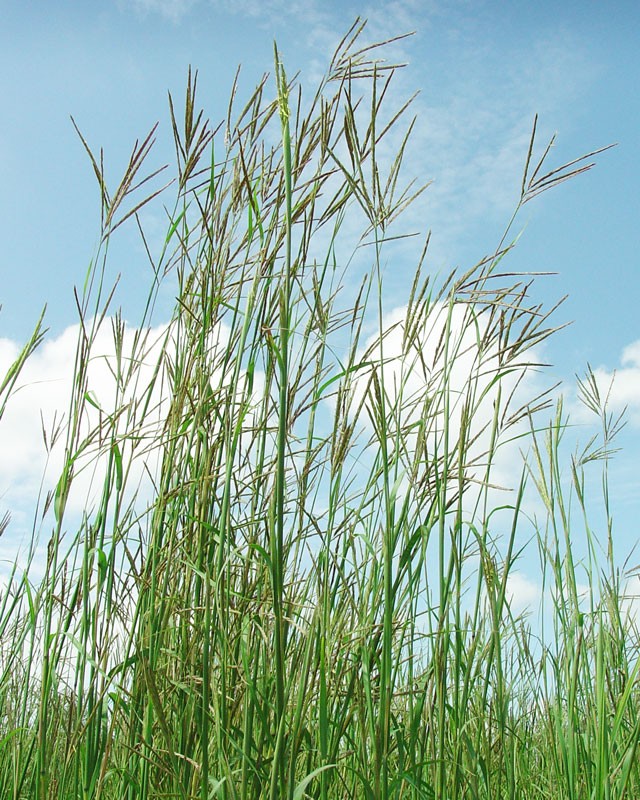

Thanks to Shalene Hiller Navant, City of Westminster for this pieceĤ1 responses to “A grass worthy of applause – Standing Ovation little bluestem” Standing Ovation little bluestem (Schizachyrium scoparium ‘Standing Ovation’PP25,202)
#Big blue stem grass care full#
Standing Ovation grows best in full sun and drier soils and pairs nicely with the prairie native Chocolate flower ( Berlandiera lyrata) and selection of the Mexican native Vermilion Bluffs ® sage ( Salvia darcyi ‘Pscarl’).īrought to Plant Select ® by North Creek Nurseries. This grass keeps its good color through the winter until it is cut to about 3” from the ground in the spring, allowing for fresh new blue foliage to emerge. The bronze cast of the winter foliage looks stunning against a fresh snow. The foliage stands tall through most winters, giving much needed winter interest and texture. The blue and purple summer color changes to spectacular oranges in the fall. Summer brings on the tall flowering spikes, followed in the fall with fluffy white seed heads that are a good food source for many local birds.

During the growing season it has superior bluish green leaves turning to shades of purple at the base. Standing Ovation little blue stem is a clump forming grass, so it does not run and become weedy in the garden.

It remains uniform in the landscape, giving your garden a much cleaner and formal appearance. Standing Ovation was selected for its superior tight, upright habit. Little bluestem is better suited for our high and dry environment than other overused ornamental grasses. It prefers full sun and soil on the dry side. It is a warm season grass, greening later in the spring than your blue grass lawn, but tolerating the heat and drought of the summer better. Little bluestem grass is native to the prairies of North America. Standing Ovation is a superior selection of our native little bluestem grass. With its adaptability, there are a variety of spaces where you can place it in your yard.A grass worthy of applause – Standing Ovation little bluestem You will love the look of this tall grass. It will make itself at home in a contemporary or cottage garden design. You should not think that the Big bluestem can only adapt to those rough and wild landscapes. It can quickly become an exceptional backdrop for those wildflower gardens. If you want to create a naturalized border for your property, this grass should be your top pick. Since it is a native plant, many communities use the Big bluestem along roadsides and parkways. With its massive size and low maintenance, this bluestem is the ideal choice for any open space. Your open spaces are filled with color throughout the year as you cover up those bare areas. With a mass planting, the richness of this plant stands out. Along with the color, it can produce shelter and food for rabbits, birds, and other animals. If you have a wildlife garden, you definitely want to add this grass to your space. This tall grass can thrive anywhere from a sunny garden to a native rock bed. You don’t need a prairie to enjoy the beauty of the Big bluestem. In the winter, the seed heads and leaves transform into an amber tone. Your landscape comes alive with shades of orange and red. This native grass does not disappoint in the fall. Many people say these branches resembled a turkey foot.īy late summer, the grass has developed an upright form with bluish-green foliage and purplish flowers. When the seed heads are formed, they spread out into three branches. These slender stems often produce hairy or fuzzy leaves. In the spring, the green stems begin to emerge out of the ground. This bluestem has a very leafy base, and some of those leaves can develop on the stems. The Big bluestem lives up to its name as it can reach a height of 6 to 8 feet high. This perennial grass can grow tall and produces some seasonal interest for your outdoor spaces. This native grass is often called the “King of the Prairie,” and it is usually found in fields, prairies, savannas, and glades. Since it dominated the prairies, this grass also flooded the landscape with seasonal color changes. This tall prairie grass was once found throughout the Midwest and provided food for wildlife.


 0 kommentar(er)
0 kommentar(er)
